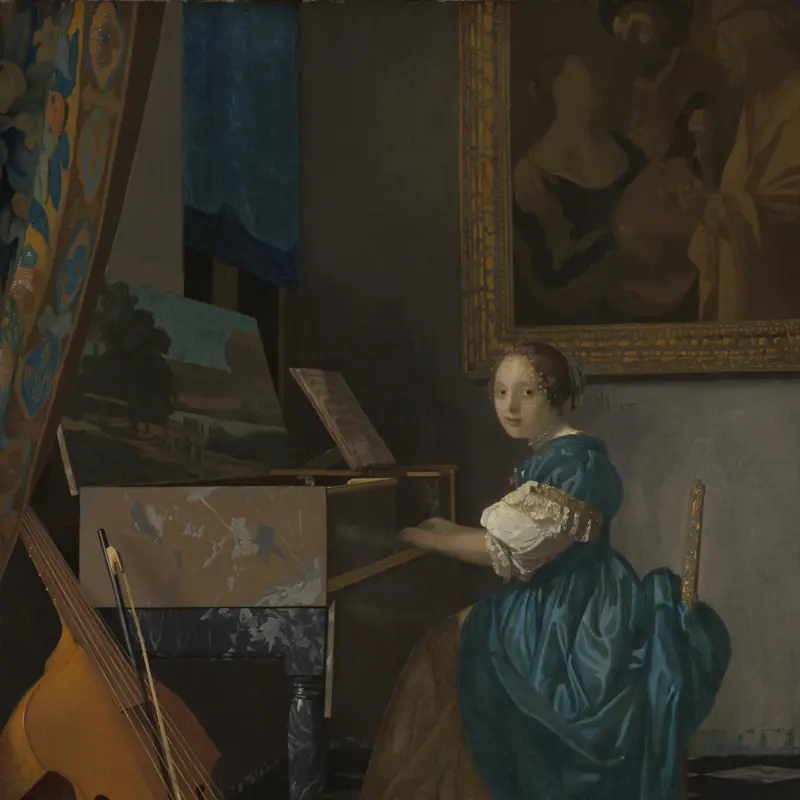Johannes Vermeer, 'A Young Woman standing at a Virginal', about 1670-2
About the work
Overview
The young woman at the keyboard holds our eye with a direct gaze. The empty chair suggests she is expecting someone and the large painting of a naked Cupid, the god of erotic love, on the wall behind her may be a signal that she is waiting for her lover. Scenes of music making were a popular genre in seventeenth-century Holland. They were often associated with romantic encounters, sometimes obviously bawdy ones, sometimes apparently innocent. Here, the style of the Cupid painting derives from a book illustration on the theme of faithful love.
There has been much speculation that this picture and another by Vermeer, A Young Woman Seated at a Virginal (also in the National Gallery), might have been made as a pair. There are many similarities between the two, but also an apparent contrast. One may represent fidelity, the other a venal, mercenary approach to love.
Audio description
Listen to an audio description of Vermeer’s 'A Young Woman standing at a Virginal'
Transcript
This is a description of a detailed oil painting called A Young Woman standing at a Virginal, by the Dutch artist Johannes Vermeer. The work is small, about half a meter square, and was created between 1670 and 1672. The image features a well-dressed young woman in a nicely decorated room. She’s standing at a virginal: a musical instrument that resembles a piano, or harpsichord. The woman takes center stage in the painting, her graceful posture commanding our attention. She stands facing her instrument which is on the right, her delicate hands resting on the keys in front of her, while her head turns toward us with a modest smile. She has a pale, rounded face and dark brown eyes that gaze directly at the viewer. She wears a bell-shaped, floor-length skirt made of pale-yellow silk, with each fold carefully delineated, capturing the way light and shadow play upon the delicate material. Her top made of blue taffeta is richly decorated with reddish pink ribbons and pearls. Billowing white sleeves complete her ensemble, leaving her forearms exposed. Her hair is worn in the style of the time, tucked up into a small red and grey bonnet at the back, her blond curls and forehead partly covered by a lace veil. She wears a pearl necklace. The room she is standing in is painted white and has a bright, airy feel. The image is cropped, revealing part of the rear wall and a glimpse of the wall on the far left. This wall has several large, lead-paned windows in it, letting soft light flood the painting. The floor is paved in bold dark blue and white tiles: the darker tiles forming cross shapes. The floor is enclosed by a row of white delft tiles featuring intricate patterns where a skirting board would typically be. Hanging on the rear wall there are two paintings. On the left is a small, traditional landscape rendered in green, blue, and white tones. It has a gilded frame that reflects the light, outshining the picture inside it. To the right is a much larger painting in a dark, matte wooden frame. This painting is intentionally symbolic: it depicts a naked baby, with blond hair, and wings. This is Cupid, God of love, holding a bow in his right hand and a playing card in his left. The card is raised above his head as if trying to catch our attention. The card contains the motto: ’Only one’. In the foreground, on the right, the wooden lid of the virginal is open, revealing a painted landscape beneath a blue, cloudy sky. Positioned nearby is a simple wooden-framed chair, slightly angled away from us and ready for someone to sit and listen to the music. The chair is covered in rich dark blue velvet with golden studs, shimmering in the light streaming from the window. What distinguishes Vermeer's work from that of his contemporaries is his mastery of light. With it, he creates an atmosphere that enhances the narrative within the painting. This is beautifully demonstrated here: not only with the clarity of daylight streaming in through the window, but also in Vermeer’s skill in the subtle effects of light on objects in the room. This interplay reveals volume, casts delicate shadows, and defines the spatial relationships. The fine silks, glistening pearls, the golden frame, the opulent velvet upholstery indicate the young woman's affluence. Symbolic hints, such as Cupid's motto, the vacant chair, and her inviting smile, suggest she anticipates a particular kind of love—idealised and virtuous. As visitors to this scene, we stand just outside the frame, invited into her world.
Key facts
Details
- Full title
- A Young Woman standing at a Virginal
- Artist
- Johannes Vermeer
- Artist dates
- 1632 - 1675
- Date made
- About 1670-2
- Medium and support
- Oil on canvas
- Dimensions
- 51.7 × 45.2 cm
- Inscription summary
- Signed
- Acquisition credit
- Bought, 1892
- Inventory number
- NG1383
- Location
- Room 16
- Collection
- Main Collection
- Frame
- 17th-century Dutch Frame
Provenance
Additional information
Text extracted from the ‘Provenance’ section of the catalogue entry in Neil MacLaren, revised and expanded by Christopher Brown, ‘National Gallery Catalogues: The Dutch School: 1600–1900’, London 1991; for further information, see the full catalogue entry.
Exhibition history
-
2012Vermeer: the golden century of Dutch artScuderie del Quirinale27 September 2012 - 20 January 2013
-
2013Vermeer and Music: The Art of Love and LeisureThe National Gallery (London)26 June 2013 - 8 September 2013
-
2021The Director's Choice: Lizards, Fancy Feathered Hats and TrickeryThe National Gallery (London)5 May 2021 - 9999
-
2021Johannes Vermeer. On ReflectionGemäldegalerie Alte Meister (Dresden)10 September 2021 - 2 January 2022
-
2023VermeerRijksmuseum Amsterdam9 February 2023 - 4 June 2023
-
2024National TreasuresNational Galleries of Scotland10 May 2024 - 8 September 2024
Bibliography
-
1821C. Josi, Collection d'imitations de dessins d'après les principaux maîtres hollandais et flamands, London 1821
-
1866E. Thoré-Bürger, 'Van der Meer de Delft', Gazette des beaux-arts, II, 1866
-
1888H. Havard, Van der Meer de Delft, Paris 1888
-
1892C. Hofstede de Groot, 'De veiling Bürger-Thoré', De Nederlandsche Spectator, 1892
-
1893C. Hofstede de Groot, 'Paris, Hôtel Drouot. Die Auction Thoré-Bürger', Repertorium für Kunstwissenschaft, 1893, pp. 118-9
-
1898M. Rooses, 'De Hollandsche Meesters in de National Gallery te London. Jan Vermeer van Delft. Het vrouwtje bij het klavier', Elseviers Geïllustreerd Maandschrift, XV, 1898, pp. 352-60
-
1907C. Hofstede de Groot, Catalogue Raisonné of the Works of the Most Eminent Dutch Painters of the Seventeenth Century, 10 vols, London 1907
-
1907C. Hofstede de Groot, Catalogue Raisonné of the Works of the Most Eminent Dutch Painters of the Seventeenth Century, 10 vols, London 1907
-
1911E. Plietzsch, Vermeer Van Delft, Leipzig 1911
-
1911P. Alfassa, 'Les Vermeers de la Galerie Nationale de Londres', Revue de l'art ancien et moderne, XXX, 1911, pp. 401-8
-
1928G. Delbanco, Der Maler Abraham Bloemaert (1564-1651), Strasbourg 1928
-
1936V. Bloch, 'Pro Caesar Boetius van Everdingen', Oud Holland, 1936
-
1937P.L. Hale, Vermeer, eds F.W. Coburn and R.T. Hale, London 1937
-
1938A. Heppner, 'Thoré-Bürger en Holland', Oud Holland, 1938
-
1939A.B. de Vries, Jan Vermeer van Delft, Amsterdam 1939
-
1946A. Blum, Vermeer et Thoré-Bürger, Geneva 1946
-
1948S. Sulzberger, 'Ajoute à la bibliographie de Vermeer de Delft', Kunsthistorische Mededelingen, III/2, 1948
-
1950P.T. Swillens, Johannes Vermeer Painter of Delft: 1632-1675, Utrecht 1950
-
1958L. Goldscheider, Jan Vermeer: The Paintings: Complete Edition, London 1958
-
1960Maclaren, Neil, National Gallery Catalogues: The Dutch School, 2 vols, London 1960
-
1960W. Stechow, 'Landscape Paintings in Dutch Seventeenth Century Interiors', Nederlands Kunsthistorisch Jaarboek, XI, 1960, pp. 165-84
-
1967E. de Jongh, Zinne- en minnebeelden in de schilderkunst van de zeventiende eeuw, Amsterdam 1967
-
1967F. Hermann, 'Who Was Solly? Part 2: The Collector and His Collection', The Connoisseur, 1967
-
1978A. Blankert, Johann Vermeer van Delft 1632-1675, English edn, Oxford 1978
-
1981L.J. Slatkes, Vermeer and His Contemporaries, New York 1981
-
1981A.K. Wheelock, Jan Vermeer, New York 1981
-
1986G. Aillaud, A. Blankert and J.M. Montias, Vermeer, Paris 1986
-
1986J. Edwards, 'La curieuse histoire de l'Astronome de Vermeer et de son "pendant" aux XVIIIe siècle', Revue du Louvre, 1986
-
1989J.M. Montias, Vermeer and His Milieu: A Web of Social History, Princeton 1989
-
1989J.M. Massing, 'Elegant Resolutions', Times Literary Supplement, 1989
-
1991Maclaren, Neil, revised by Christopher Brown, National Gallery Catalogues: The Dutch School, 1600-1900, 2nd edn (revised and expanded), 2 vols, London 1991
-
1991J.M. Nash, Vermeer, London 1991
-
1993E. de Jongh, 'Die "Sprachlichkeit" der Niederländischen Malerei im 17. Jahrhundert', in Leselust. Niederländischen Malerei von Rembrandt bis Vermeer, Frankfurt 1993, pp. 23-34
-
1994D. Arasse, Vermeer: Faith in Painting, Princeton 1994
-
1994G.J.M. Weber, 'Johannes Vermeer, Pieter Jansz. van Asch und das Problem der Abbildungstreue', Oud Holland, CVIII/2, 1994, pp. 97-106
-
1994G.J.M. Weber, '"Om te bevestige[n], aen-te-raden, verbreeden ende vercieren": Rhetorische Exempellehre und die Struktur des "Bildes im Bild"', Wallraf-Richartz-Jahrbuch, LV, 1994, pp. 287-314
-
1995A.K. Wheelock, Vermeer and the Art of Painting, New Haven 1995
-
1995A.K. Wheelock and B.P.J. Broos, Johannes Vermeer (exh. cat. National Gallery of Art, Washington, 12 November 1995 - 11 February 1996; Mauritshuis, 5 March - 9 June 1996), New Haven 1995
-
1995F.S. Jowell, 'Thoré-Bürger and Vermeer: Critical and Commercial Fortunes', in C.P. Schneider, W.W. Robinson and A.I. Davies (eds), Shop Talk. Studies in Honour of Seymour Slive, Cambridge MA 1995, pp. 124-7
-
1996R. Manwaring Baines, 'Jan Vermeer of Delft', Leisure Painter, 1996, pp. 45-7
-
1996M.A. Castor, 'Augenblick und Zeitfluß. Bermerkungen zu einigen Konstanten in der Malerei Jan Vermeers', Pantheon, 1996, pp. 84-101
-
1996F.S. Jowell, 'Thoré-Bürger: A Critical Role in the Art Market', The Burlington Magazine, CXXXVIII/1115, 1996, pp. 115-29
-
1996E. Buijsen, 'Music in the Age of Vermeer', in Dutch Society in the Age of Vermeer, Zwolle 1996, pp. 106-23
-
1997L. Gowing, Vermeer, London 1997
-
2000W.-J. Hoogsteder, 'Schilderij op Johannes Vermeer ontdekt', Hoogsteder Journal, 7, 2000, pp. 10-9
-
2001
C. Baker and T. Henry, The National Gallery: Complete Illustrated Catalogue, London 2001
-
2001R. Baarsen et al., Vermeer and the Delft School, New Haven 2001
Frame
This is a seventeenth-century Dutch ripple frame, crafted from ebony veneer. The back moulding of the box frame is adorned with a ripple moulding, followed by a scotia and a narrower ripple moulding. It has a bold zigzag ripple on the frieze, ending with a ripple moulding at the sight edge.
In 2002 a large box frame was used to make smaller frames for two paintings by Vermeer, A Young Woman standing at a Virginal and A Young Woman seated at a Virginal. Both original and replica metal corner coverings feature on the outside of the frames.
Within the painting of A Young Woman standing at a Virginal, there are two framed paintings depicted, giving us a record of contemporary taste in frames: a gold ornate frame for a landscape and a simple ebony frame for the depiction of Cupid.
About this record
If you know more about this work or have spotted an error, please contact us. Please note that exhibition histories are listed from 2009 onwards. Bibliographies may not be complete; more comprehensive information is available in the National Gallery Library.



